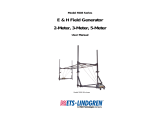
wc_tx001970gb_FM10.fm
16
Installation PS 3-Phase Series
Precautions During Installation
When installing the pump, pay close attention to its center of gravity and weight. If it
is not suspended properly, it may fall and be damaged or cause injury.
When transporting the pump manually, be sure to employ manpower
commensurate with the weight of the pump. To avoid back injury when lifting the
pump, bend the knees to pick it up rather than bending your back only.
Do not under any circumstances install or move the pump by suspending it from
the cable assembly. The cable may be damaged, causing electrical leakage,
shock, or fire.
1. This pump series is offered with a variety of discharge fittings. Please re
fer to
the BOM Product Matrix in t
he Parts Section to identify the type of discharge
fitting used on your pump. Follow procedures noted below to assure a prop
er
discharge connection.
Threaded Discharge Fitting (BSP) –
Tighten hose coupling or discharge pipe securely and with proper gaskets.
Quick Disconnect Coupling (QD) –
Assure coupling is tightened securely to pump discharge fitting and companion
coupling is securely fastened with proper gaskets.
Barbed Discharge Fitting (Barb) –
Place hose clamp over hose and push hose to the base of the discharge fitting.
Tighten the hose clamp to secure the hose in place.
2. Avoid dropping the pump or other strong impact. Lift the pump by holdi
ng it
firmly wit
h the hands or by attaching a wire rope (a) or chain to the handle.
Note: For proper procedures for handling the cable assembly, refer to Section
Electrical Wiring in this manual.
Do not operate the pump dry. Doing so will prevent the pump from attaining its full
potential and may also damage the pump and lead to a short and electrical shock.
In order to properly discharge water, provide adequate piping to the area where the
pump is mounted. Improper piping may lead to water leakage or other
malfunctions.Install the pump only in an area that can maintain a proper water
level.
3. Install the pump only in an area that can maintain a proper water level.
Note: For details on the water level necessary for pump operation, refer to “Water
Level During Operation” in the Operation section.
4. When using a hose to provide piping to the pump, observe the following:
Use the shortest possible length of discharge hose and minimize the number o
f
bends. V
erify that the end of the hose (discharge side) is lifted above the wa
ter
surface (a).
If the end of the hose is submerged in water, it may cause the
water
to flo
w back (b) when the pump has been stopped. If the end of t
he hose is
loca
ted at a level that is lower than that of the source water surface
, water may
continue t
o flow out even after the pump has been stopped.
Note: Appropriate piping materials must be provided by the user. Piping materials
are not included with the product..
If large quantities of sediment are drawn into the pump, damage resulting from
wear to the pump can lead to current leakage and electrical shock.






















